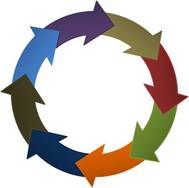
Many academics and practitioners alike have for many years been looking at how we can sustain our economic wellbeing without depleting our resources. Some, like Tim Jackson, have suggested we can have ‘prosperity without growth’, or slow down growth significantly, but I don’t buy this – and nor does Peter Lacy, who said that this is simply not a conversation you can have in Asia (the area he covers) where billions of people want to lift themselves out of poverty.
Instead, we need circular economy thinking (as opposed to our current ‘take, make, dispose economy’). Jamie summarises the circular economy as “a framework for an industrial economy that is restorative by intent. At an individual business level this provides the opportunity for businesses to begin to decouple economic growth from resource constraints and drives innovation and value creation”. The short, eloquent clip by Dame Ellen MacArthur below also summarises the concept really well using her sailing experience as an analogy.
Peter outlined five business models for circular economy thinking and they make great lenses through which to innovate. They’re not all new, but are very compelling.
Products to services
“Every product is a service waiting to happen”. To my mind, this drives much of the rest of the circular economy thinking. The key is to get to the heart of the customer value proposition and look at how we can reframe it. Are we selling cars or mobility? Gas or a warm house? Light bulbs or light? For example, Philips has started selling lumens of light to municipalities for their street lighting, thus retaining ownership of the assets and reusing the resources at the end of the life-cycle.
More radically, how might you make shoes a service? Timberland have been trialling exactly this with the ‘Earthkeeper’ shoe for kids. Kids of a certain age are notorious for going through many pairs of shoes a year, so instead of buying, say four pairs a year for $50 a go, Timberland will sell you the right to a shoe for your child for $100. Timberland retain ownership of the shoes and recovers many of the materials at the end of the life-cycle. It also has the great benefit of ‘closing the customer loop’ as customers are not exposed to the marketing mix and competitor products as they would every time they go back to a store to buy new shoes.
Sharing economy
We have talked about this trend on our blog before, but there is much scope for it to grow. How can you use (digital) technology and social media to create ‘clearing houses’ to create a sharing effect, ultimately leading to a radical shift in heavy resource use? Great and prominent examples include Airbnb, ZipCar and Uber, highlighting how the sharing economy can drive growth with limited resource use; indeed, Airbnb now has a market cap to rival all major hotel groups.
Circular supplies
Looking at the supply chain and asking how we can make our inputs more circular, be that through R&D, supplier or even competitor collaboration. An obvious example is renewable energy in the manufacturing process and a more high tech one is around ‘green chemistry’ as demonstrated by Dutch chemical company DSM, who have developed some bio based substitutes designed closed loop from the start.
Resource recovery
Driven by service vs. product thinking, how do we design for disassembly and resource recovery from the start and ensure we maintain ownership of the raw materials? Much like Interface in the US, Dutch carpet supplier Desso are also pioneers in the sustainability field: they rent out carpets by the tile, replacing just the ones that are spent and reusing the materials for new carpet. This allows for lower costs for customers, predictable input costs, increased profits and radically reduces resource use.
Product life extension
Linked to the above, how do we create products to maximise their life-cycle from the start? How do we design for remanufacture and refurbishment from the outset? For example, BMW now designs parts which in some cases up to 80% of the part can be refurbished and re-used – and put back into the market with the same warranty levels.
According to Peter, over 50% of 1000 global CEOs interviewed as part of a UN study, said they are introducing circular economy initiatives in the coming years. Whilst it is early days, it is clearly moving from being a niche concept to a more mainstream reality with huge potential for innovators.
| | |


 RSS Feed
RSS Feed